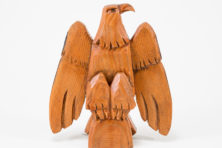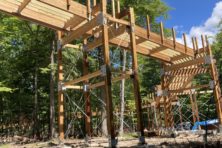Eagle Tower Wood Analysis Shows Severe Decay
- Share
- Tweet
- Pin
- Share
“This is really scary,” was a common refrain by Bob Ross, a wood expert with the U.S. Forest Service, reviewing pictures of the deteriorated wood that was once Eagle Tower. Ross presented his team’s findings to the public on Oct. 18 after running hundreds of tests on each piece of wood from the dismantled Eagle Tower.
Of the four main tower legs, two were in good condition, one had spotty deterioration and one was completely rotted from top to bottom.
“What we think caused that was a pileated woodpecker nest, they drilled in the side and water got in it,” said Ross of the rotted leg. “These were designed to have a service life of about 30 years, the state of Wisconsin got 80 years out of it.”
When the tower was first closed for safety concerns, some residents questioned the validity of the inspections, saying the weight bearing loads and assumptions of wind speed were overblown. After taking apart the wood, Ross thought they closed it just in time.
“We made some really good decisions. This thing was very, very severely deteriorated. So we made a good decision here,” said Ross. “The scary part about that is that the property that’s most affected by decay is impact. What tipped me off there was a problem…I went up to [the railing] with my knee and it bent out six inches. If a kid hits that, they’re going to go right straight through it.”
He determined that while enough of the wood was rotted to cause safety concerns, there was still plenty that could be repurposed around the park, but not in the new Eagle Tower.
“I do think there’s some good recoverable material that we could use in the next Eagle Tower, albeit I think it should be used in nonstructural application,” said Ross.
Missy VanLanduyt, capital development director with the Department of Natural Resources (DNR), said they are looking at options of repurposing the wood in benches, kiosks and informational stands around the park. The DNR will also sell some of the wood to the Friends of Peninsula State Park “at something like one dollar” to resell as a fundraiser for the tower.
The Eagle Tower Fund has $250,000 pledged towards its $750,000 goal.
“We wanted to figure out which pieces were recoverable,” said Ross. “One thing we focused on was not just bulldozing, we dismantled it. They were very persnickety to make sure those things didn’t just get wasted.”
To test the wood, Ross’ team first sent sound waves down the length of the roughly 20-foot members and timed how long it took the sound waves to travel through the wood. In rotted wood, sound travels slower, so the logs that had significant rot would return sound waves in a longer period of time than those that were still strong. Once they determined which logs had significant rotting, they took another sound tool that could measure the amount of rot in the width of the log.
All of these techniques gave the wood experts the ability to determine usable wood without having to break it apart.
Wood recommends the new tower be constructed using treated square members similar to the tower built at the Sheboygan Marsh.
“We’re going to take a few things for interpretation and education to use in the nature center and have this historical reference,” said VanLanduyt. “We’re working through architects and engineers and then the fundraising will continue. Hopefully we can get under construction in late 2017 or early 2018.”




